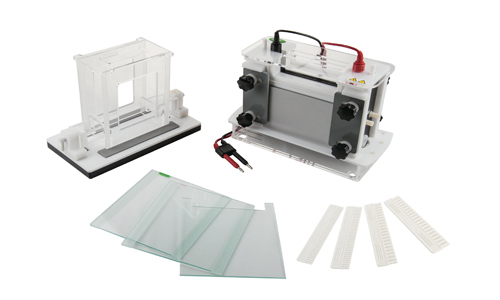The power source for electrophoresis chambers is the source in charge of providing electricity to the electrophoresis system that is being used, in other words, it provides the necessary energy for this system to function properly; reason for which it is considered an essential element to carry out the electrophoresis technique.
How does a power source for electrophoresis chambers work?
The power source for electrophoresis systems converts the alternating current that comes from the electrical supply, into direct current, and distributes it to the devices that request it. That is why it acts as a transformer, rectifier and as a regulator at its output, to avoid voltage peaks that damage the system.
The power of the Electrophoresis Power Source is designed for use in separating DNA, RNA, and proteins. And you must bear in mind that failures in the power supply of the electrophoresis chambers, can in turn cause failures in the execution of the technique, so we must ensure that it works in the correct way and that its capacity is sufficient to cover the power requirements of all internal components of the electrophoresis system.
What is the principle of operation of electrophoresis?
Recalling a bit the principle of electrophoresis, we find that it is a technique that consists of the migration of molecules through a gel or matrix of a porous nature, where by the application of an electric field, they will be separated according to their size or molecular weight, this thanks to the action of a power source for electrophoresis chambers.
Electrophoresis chambers can be classified according to the way the support is arranged, horizontally or vertically. The horizontal ones are characterized by the fact that the buffer completely covers the gel, it has some wells in which the sample is deposited; those of the vertical type are used exclusively with polyacrylamide gel.
The migration and separation of the soluble molecules in the sample is carried out by passing an electric current through the matrix for a specified time and continuously. The separation and the migration speed depend on several factors, such as, among others, the electrical charge of the molecules, the type of matrix and the thickness of the same, the ionic strength and the composition of the buffer solutions that are used to elaborate the matrix. In this way, molecules with a positive electric charge migrate towards the negative pole (cathode) and molecules with a negative electric charge migrate towards the positive pole (anode). Once the molecules have migrated, their position is determined, applying a specific stain for the molecule under study.
There are two aspects that are key in performing electrophoresis: first, the physicochemical elements, which comprise the regulatory solutions used in the preparation of the matrix and the electrolytic solutions responsible for ion exchange and charge flow through the system. ; second, the electrical part related to the supply of current and voltage necessary for the separation of the components to be studied.
That is, without an adequate power source for electrophoresis chambers it is impossible to have the expected results in the execution of this very important technique in the field of science and research.
With that in mind, at Kalstein we offer you a new electrophoresis system with an excellent power source, at the best PRICES on the market since we are MANUFACTURERS. That is why we invite you to take a look at the Products menu. HERE


